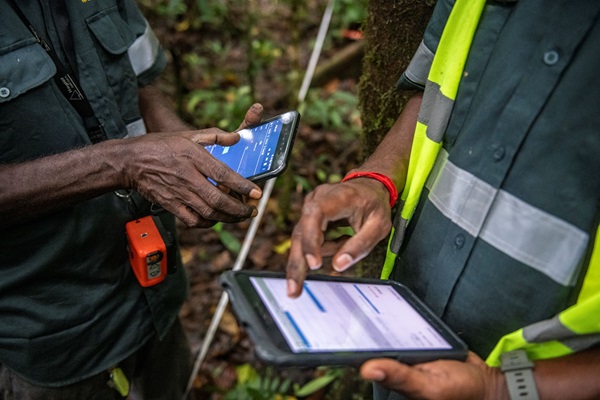
Rome – The Food and Agriculture Organization of the United Nations (FAO) today marked International Day of Forests by showcasing transformative innovations such as advances in forest monitoring, early warning systems and other vital technical solutions that are being used to help countries halt deforestation and forest degradation.
“We are in the midst of a forest data revolution driven by innovation and technology, enabling countries to track and report on their forests more easily and effectively,” said FAO Deputy Director-General Maria Helena Semedo. “With 10 million hectares of forest lost annually due to deforestation and approximately 70 million hectares affected by fires, new solutions are essential.”
FAO hosted the International Forest Day 2024 with the organization of an event including an exhibition and technical sessions on themes ranging from how innovation is advancing ecosystem restoration and how it can empower Indigenous Peoples through mapping and securing rights to customary land.
Technological innovation has vastly improved our ability to monitor the world’s forests and offer a robust way to guide actions to protect, restore and sustainably use forests and in particular, can empower Indigenous Peoples who take care of many remote forested areas.
Technological innovation and associated scaling up of practices in 20 countries, including innovative work with Indigenous Peoples in Papua New Guinea , has been enabled thanks to $30 million in support from the United Kingdom for the AIM4Forests initiative in 2023 and implemented in collaboration with UN-REDD and GFOI. The project aims both to provide countries with the technological means to combat deforestation and ensure the active participation of Indigenous Peoples in forest monitoring and has already been rolled out with a sense of urgency in 11 countries.
“The UK is leading the way in supporting developing countries to adapt to climate change and protect precious forests that are vital to keep 1.5 alive,” said Graham Stuart, the United Kingdom’s Minister for Energy Security and Net Zero. “With our partners at FAO, we are proud to support the AIM4Forests programme, sharing UK expertise to deliver innovative technologies that will monitor and tackle deforestation.”
Expanding the frontier with Google and other partners
The International Day of Forests event saw the launch of Ground, a pathbreaking new mobile application within FAO’s highly-successful Open Foris initiative, developed in collaboration with Google and benefiting from the increasing availability of satellite imagery.
Open Foris already includes SEPAL and Earth Map, which allow users to access and process historical and new satellite data that, thanks to the intuitive ease and big-data capabilities of Google Earth Engine, enable highly granular visualization and statistical analysis of vegetation, climate, water, forests and other datasets that can generate tailored products for local needs both quickly and for free.
Some 90 percent of countries reporting 13.7 billion tonnes of forest emission reductions or enhancements used Open Foris. Open Foris has been used by over 200,000 individuals from 196 countries.
Ground is the fruit of a collaboration between Google, FAO and other partners. It is specifically designed for non-technical users who work where internet bandwidth is scarce or absent, allowing indigenous people and farmers to collect information on their area of forest or agricultural plots. Ground was successfully piloted by FAO in a recent field application in Papua New Guinea and Ivory Coast, and promises to be an important participatory and technical solution to accelerate restoration efforts, enable small-holder participation in regulated markets, and bolster initiatives to demarcate customary lands.
“Open Foris Ground was envisioned as a map-based tool that could be used in a variety of contexts with little or no special training. Indigenous people can collect data about their own lands with minimal outside help, on top of high-resolution satellite imagery from Google Earth,” said Google Earth Director Rebecca Moore. “Open Foris Ground enables smallholder farmers and local communities to report data that’s important to their livelihoods, from the ground to the cloud. This is the most recent development in our near-decade long partnership with FAO, where among other efforts, we helped countries realize forest-based climate action,” she added.
Ground will help further technological innovation across FAO’s mandate and inaugurates a new multi--year Memorandum of Understanding signed today between FAO and Google. The new MoU will deepen the engagement from the MoU signed in 2015, which has catalyzed numerous geospatial solutions enabling FAO Members to dramatically upscale environmental literacy and implement science-based policies in practically real time, not to mention combat locusts.
Wide array of benefits from digital public goods
It is increasingly evident how large a role forests will play in climate actions. That makes transparent and reliable assessments of forest carbon fluxes even more imperative, both to improve knowledge and to unlock results-based finance.
The important technological contributions made in the past decade, buoyed by the provision of digital public goods as demonstrated by FAO, Google Earth Engine and many other Open Foris partners, offer grounds for optimism.
FAO’s recent publication, “Technological innovation during transparent forest monitoring and reporting for climate action”, reviews how countries are benefiting from new technologies and their dissemination, with usable satellite imagery driving transformational approaches. The more robust estimation methods now available point to strong prospects for new types of climate finance, including through linkage to carbon markets, and an expansion of the range of actors able to drive and benefit from the emphasis on sustainability.